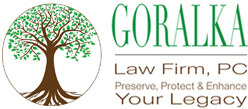Estate Planning for the Modern Blended Family
by John M. Goralka, J.D.
Sacramento, CA
 As a child, I grew up watching “Leave it to Beaver.” Ward and June Cleaver, Wally, Theodore, and Eddie Haskell (the Beaver). The estate planning goals and challenges for the Cleaver family were unique. More often, all assets are left to the surviving spouse with few if any restrictions. There was little or no concern that Ward or June would disinherit the children after the first spouse’s death. At the death of the surviving spouse, the kids, Wally and Theodore would receive their respective shares of the trust estate perhaps, at appropriate ages when they were financially mature enough to manage the wealth. There was little concern then about long term divorce or asset protection.
As a child, I grew up watching “Leave it to Beaver.” Ward and June Cleaver, Wally, Theodore, and Eddie Haskell (the Beaver). The estate planning goals and challenges for the Cleaver family were unique. More often, all assets are left to the surviving spouse with few if any restrictions. There was little or no concern that Ward or June would disinherit the children after the first spouse’s death. At the death of the surviving spouse, the kids, Wally and Theodore would receive their respective shares of the trust estate perhaps, at appropriate ages when they were financially mature enough to manage the wealth. There was little concern then about long term divorce or asset protection.
Increasingly, today’s family more closely resembles Jay Pritchett’s family on the TV series “Modern Family”. Jay has two (2) grown children, Claire and Mitch, and (4) grandchildren. Jay also has a stepchild with his second wife Gloria. Manny, Jay’s stepson, lives with Gloria and is a member of the family and household. The Cleaver family estate plan does not work for the Pritchett family. How will Jay know that his kids will inherit after his death? Could Gloria change the beneficiaries after Jay’s death? How can Gloria be sure that Manny is provided for? Claire works in Jay’s business while Mitch is a practicing attorney. Should Claire receive the business and Mitch receive other assets or insurance proceeds to balance the inheritance? Both Claire and Mitch are married. As discussed below, the estate planning issues between Claire and Mitch’s family are also different.
The estate planning needs and concerns for the Cleavers are very different for those facing the Pritchett family. These lady bird deed michigan estate planning needs and concerns of this modern blended family very often lead to an emotional journey while finding a solution.
Identify Goals, Concerns, and Heirs.
The first goal is to probate and to clearly identify your desired heirs or beneficiaries. What concerns do you have regarding their ability to handle money? Are you concerned about divorce or lawsuit protections? What are their needs? Probate alone subjects their estate and family to higher costs, time delays, and the public nature of a formal court proceeding. Heirs, names, inheritances, assets, and values are public information. A two (2) million-dollar estate can easily cost $70,000.00 to $100,000.00 or more in fees and costs.
Failure to identify your heirs or beneficiaries and their needs is particularly problematic for a blended family. The failure will cause reliance upon the probate code in the state of residence. The probate code is far less likely to identify the desired heirs or beneficiaries of a blended family. Planning should also address who is authorized in the event of incapacity to make medical decisions. The failure to do so can result in an undesired family member with authority to decide.
Use a Trust in Order to Avoid Probate.
A recent client tragically lost her husband who handled all of the finances for the family. All assets were held in the husband’s name. As a result, the probate code in California limited the stated beneficiaries or heirs as 1/3 for the surviving spouse and 2/3 for the children including one (1) minor child. This was a tremendous shock for an already grieving family. The surviving spouse felt that she was a fifty (50) percent owner of the combined assets As a result of COVID-19, many court calendars remain delayed requiring four (4) and five (5) months or more to wait for a hearing. While that seems to be improving in many counties, delays remain an issue. Before COVID-19 or these delays, a routine probate could often take one (1) year or more. That is a long time for families to wait for characterization of assets. The solution: use a trust and not a will.
Community or Separate Property.
In many states, including California, property for marital couples is characterized as community property (jointly owned) or separate (owned separately by one spouse). There is a separate interstate succession plan in the probate code for each type of property. Note that this is based on the recorded title of the property in the absence of a premarital (or post marital) agreement. Care should be taken by both spouses to take title to property, assets, and accounts in an appropriate manner.
The characterization of property can affect rights to income and responsibility for debts, calculation of income tax basis at a death, and the allocation of assets at divorce. If separate assets are mixed with community assets, then the separate asset may lose its separate character.
In simplest terms, thought should be given about long-term goals in the event of a death. Jay Pritchett may wish that some assets be distributed to his children at his death, even if Gloria is alive. Gloria may be closer in age to Jay’s children than Jay.
Providing for the Surviving Spouse and the Deceased Spouse’s Children.
Jay may also want to be sure that Gloria is taken care of financially. He may wish to provide for Gloria during her life, but restrict her from changing the beneficiaries to be what she may remain at Gloria’s death to be sure that the remainder goes to his children. This can be problematic for estate tax purposes, so consider a Qualified Terminable Interest Trust (“QTIP”) Election.
Jay may be concerned about the level or amount of support he provides Gloria if she remarries after his death. He may address this possibility or establish limits in the trust.
For the traditional family, you will more commonly see all assets going to the surviving spouse with few, if any restrictions. The surviving spouse provides for the kids at his or her death under the provisions of a joint trust. Even then, many couples fear the effect of the surviving spouse’s remarriage or of the susceptibility to undue influence by others in old age or poor health. Many families will “lock in” the distribution or allocation to their kids upon the surviving spouse’s death. This is done by providing for the deceased spouses assets being retained in the trust (or a portion). The trust provides for all of the income to go to the spouse and discretionary distributions of principal. The trustee’s discretion can be limited such as for health, education, maintenance, and support (“HEMS”). The spouse may not change the beneficiaries at her death. A QTIP provision is suggested to permit this trust to qualify for the marital deduction for estate tax purposes.
Use a Premarital Agreement.
For holders of substantial separate property, a premarital agreement and a separate property trust are recommended to preserve the separate property character, and to protect property from claims from the new spouse or his or her family at death. This approach also makes challenge less likely because separate and community assets and beneficiaries are not mixed or comingled together.
Separate or Joint Trusts?
A good premarital agreement will also establish rights to income and responsibility for debts during marriage. This can provide asset protection to benefit both spouses. If one spouse is in a risky profession, this may help protect the other spouse from any related liability or lawsuits.
If separate assets are not as substantial, then a joint trust can be used and retain the separate property character. However, you may have difficulty funding separate investment and bank accounts for separate property in a joint trust due to bank policies, restrictions, or perspectives.
Selection of Trustees.
In a blended family, couples often seek to have representatives from both family groups as trustees or decision makers. That is, one of Jay’s kids to serve with someone from Gloria’s family. This sounds good, but there is the potential for deadlock if one side says “yes” and the other says “no”.
In the event of a deadlock, each co-trustee retains a lawyer which can result in very substantial fees. The trust may also retain an attorney. One solution is to use an independent tiebreaker. Each side pleads his or her case and the tiebreaker makes a “King Solomon” type decision to resolve the dispute.
Co-trustees can also be problematic from a practical perspective. Typically, both Trustees need to sign each bank or financial instrument due to bank policy. Finding time can be challenging without having to coordinate with someone else who may live in a different time zone.
A better approach may be a professional fiduciary who is not beholden to or favor either side. This often cuts through any emotional baggage being carried by either side of the family.
Jay may consider utilizing specific assets for different beneficiaries or groups of beneficiaries, for example:
- Life Insurance – Either for Gloria or to Jay’s kids at his death. That way Jay’s kids are not “waiting for Gloria to die”.
- Family Business – To family members working in the business, the challenge here is that often the estate’s value may be disproportionately found in the business. Again, insurance may be a good equalizer.
- Distributing Certain Assets/Investments at Jay’s Death – Due to the age difference, this may help the modern blended family where kids are left watching a “stepmother” enjoy their father’s assets and feel left out or forgotten.
- Retirement Funds – A separate IRA Inheritance or Legacy Trust can be established with a Nevada Domicile for Jay’s children.
This structure can help avoid California tax and can “stretch” on a deferred tax basis for many years. These are just a few thoughts regarding planning for the modern, blended family. The first step is a clear understanding of the assets being planned for both as the type of the asset and also its separate or community property character. The next step is to explore the goals of both Jay and Gloria in order to obtain the best results.
John Goralka is the lead attorney and founder of the Goralka Law Firm, P.C., and is an experienced Sacramento estate planning and tax planning lawyer.
For help in Sacramento with estate planning or tax planning, please contact our office.

